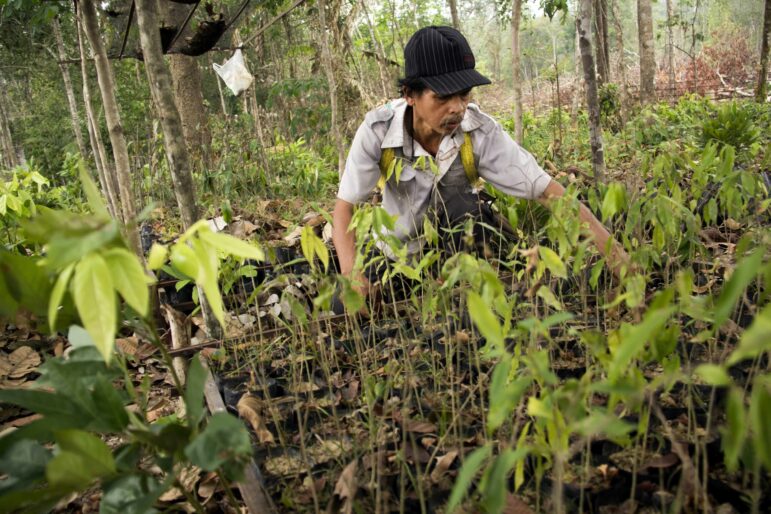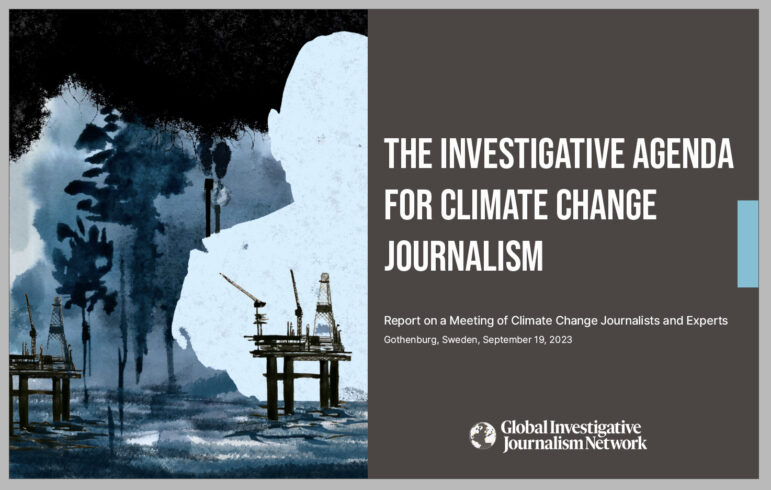

Holding Your Government Accountable for Climate Change Pledges
Read this article in
Is your government living up to its promises to fight global warming?
The international diplomatic effort on climate change revolves around national pledges. The strength of these voluntary commitments by individual governments and whether they are being fulfilled are critical questions.
This is where investigative journalists can fill a vital role.
This GIJN guide will tell you:
- Where to learn about your government’s commitments.
- Where to find out about your country’s actual greenhouse gas emissions.
- How to examine what financial aid your country needs because of climate change.
- Where to see what financial commitments are being made by the developed countries to help developing countries.
Documents from governments provide vital starting points for many investigations.
National commitments cover many topics. Each may well be worthy of separate scrutiny on its own.
This is the condensed version of a longer guide on the same topic which contains more detail.
Starting Points
The key place to look for your country’s commitments is in the documents filed under the United Nations Framework Convention on Climate Change (UNFCCC).
There are many potential stories to be found based on what’s in these documents, and what’s not. Among the potential stories:
- Are the goals ambitious enough?
- Who influenced the priorities and implementing policies?
- Are the plans sufficient to fulfill the goals?
- Are the promises being fulfilled?
Ultimately, the flow of emissions data will provide answers. More on that follows.
Understanding National Commitments
As mentioned above, the core document describing each government’s voluntary pledges is known as the Nationally Determined Contribution (NDC). All 194 parties to the Paris Agreement on climate change have submitted at least one NDC, which are listed by the UNFCCC.
Find your country’s documents on the NDC Registry. Or you can sign up for an RSS feed of the latest filings.
NDCs include:
- Targets for reducing greenhouse gas emissions
- Sector-specific mitigation targets
- Plans for reaching the targets
Although countries have been encouraged to update their NDCs, most have not. At the 2022 United Nations Climate Change Conference of the Parties of the UNFCCC (COP27), parties were again encouraged to communicate new or updated NDCs in advance of the next meeting (November – December 2023) and all parties were requested to revisit and strengthen 2030 targets in their NDCs by the end of this year.
The next big round of NDCs will arrive in 2025 and are to be communicated at least nine months before COP30. Countries are ”encouraged” to look ahead to a five-year period, from 2031-2035. Some may include longer time horizons. So the time periods covered in the NDCs will likely vary.

Demolition of a former coal and oil power station in the Richborough region of the UK. Image: Shirokazan, Creative Commons via ClimateVisuals.org
Developing Countries — Identify Needs
Another foundational document is submitted by developing countries.
National Adaptation Plans (NAPs) are created by developing countries to identify medium- and long-term adaptation needs and strategies to address them. (Learn more and see links to 40 NAPs are on the UNFCCC website. UNEP posts press releases about these NAPs on its website as well.)
Evaluating Country Plans
Summaries and reviews of government plans are vital resources for reporters. Here’s a list of resources, mainly by NGOs, that look closely at NDCs.
- The International Energy Agency
- Climate Action Tracker
- Climate Watch
- Climate Scorecard
- Climate Transparency
- Pledge Pipeline
- NDC Explorer
- IMF Climate Change Dashboard
- Africa Nationally Determined Contributions (NDC) Hub
- Climate Policy Database
(Descriptions about each of these sources are contained in the longer guide.)
Finding Emissions Data
Periodic reports by governments to the UNFCCC are the places to dig into the official data on emissions (not necessarily included in the NDCs), and more.
These reports include information on:
- Greenhouse gas (GHG) emissions
- Actions taken to reduce emissions
- Steps to adapt to climate change
- Aid to countries most affected by climate change
What’s more, UNFCCC reviews of these reports are conducted, which offer insights into the sufficiency and accuracy. More on these below.
Be prepared for complexity. These government reports are not easy to read or understand for the layperson. They contain lots of figures, and they are steeped in bureaucratic and scientific jargon. So seek help and solicit expert assistance. Scientists, climate change activists, and government specialists can help interpret the data.
The UNFCCC summarizes the GHG inventory data submitted by the COP parties, with multiple options for analyzing it. For example, greenhouse gas inventory data is searchable by country, by type of emissions, by year, by industry, and more.
The UNFCCC reporting regime continues to evolve toward more uniformity of reporting, but the Biennial Transparency Reports aren’t due until by the end of 2024. In the meantime, governments are continuing to submit reports. Their type and content varies by the development level of the country. (See UNFCCC description.)
Below is a closer look at the reports and where to find them.
Overview of Key Reporting Documents
Developed countries file more frequent and more detailed reports than developing countries do.
The 43 so-called developed countries (listed as Annex I) generate:
- National Inventory Reports (NIRs), annually, due by April 15, 2023.
- Biennial Reports (BRs), completed every two years. A subset of Annex I countries disclose in the BRs what support was provided to developed countries.
Annex II parties are a subset of Annex I and are required “to provide financial resources to enable developing countries to undertake emissions reduction activities under the Convention and to help them adapt to adverse effects of climate change.”
The remaining 151 developing countries (Non-Annex I) generate:
- Biennial Update Reports (BURs). BURs are due by December in even-numbered years starting in 2014. But some countries only submitted their first reports in 2022.

The different parties to the United Nations Framework Convention on Climate Change (UNFCCC). Annex I and II countries (green), Annex I only countries (blue), and Non-Annex I countries (orange). Image: Creative Commons
UNFCCC Reviews of Country Reports
Country reports are subject to reviews run by the UNFCCC. As part of this overview process, experts probe both the completeness and transparency of the reports.
The results of these evaluations may prove useful for journalists because they show gaps and flaws in national reporting. The reports serve as a useful source of raw material, including a good summary of the government’s plans on climate change. However, the evaluators are checking for accuracy, not critiquing national ambition. These technical reviews of Annex I countries are worth analyzing.
In addition, a Multilateral Assessment is undertaken for each developed country. It begins with an expert review and then provides an opportunity for countries to question each other. The overall process is known as “international assessment and review.”
Alternative Sources of National Emissions Data
Governments provide data on their country’s emissions, but so do various international agencies and NGOs.
Here are some places to look for alternative figures:
Also, keep an eye out for new academic research. Scientists are constantly analyzing official emissions data and sometimes they make their data available.
Finding Updated Country Data
Since country reports to the UN are annual or biennial, a logical question is whether more recent country data is available.
In some developed countries, more periodic data may be available. Our longer GIJN guide on this topic lists some places to find such updated information. Unfortunately, very little national emissions data is routinely available in many countries. This lack of data, and its accuracy, may be worth probing.
Developing countries face special challenges. The demands for emissions reporting sometimes exceed what they can afford. Furthermore, it’s crucial for them to calculate the costs of climate change.
These issues present opportunities for national reporting. The longer guide references some international projects in this area, such as those by the Initiative for Climate Action Transparency (ICAT).
While stories about data quality may seem dry, they have the potential to improve critical information needed to make policy decisions. Lasse Hemmingsen, Communications Officer with the UNEP Copenhagen Climate Centre, said: “If you don’t have the data, or the data isn’t reliable, you don’t know what works.”
Glossary
Because this landscape is filled with a wealth of regulatory terms, reports, and acronyms, we’ve created a section explaining the most commonly referenced items that investigative reporters will need to know when researching the topic.
 Toby McIntosh is a senior advisor for GIJN’s Resource Center, which provides online resources to journalists worldwide. He was the editor of FreedomInfo.org, (2010-2017) a nonprofit website based in Washington, D.C. that covers international transparency laws. He was with Bloomberg BNA for 39 years and has filed numerous US Freedom of Information requests and has written about FOI policies worldwide. He is a steering committee member of FOIANet, a network of FOI advocates.
Toby McIntosh is a senior advisor for GIJN’s Resource Center, which provides online resources to journalists worldwide. He was the editor of FreedomInfo.org, (2010-2017) a nonprofit website based in Washington, D.C. that covers international transparency laws. He was with Bloomberg BNA for 39 years and has filed numerous US Freedom of Information requests and has written about FOI policies worldwide. He is a steering committee member of FOIANet, a network of FOI advocates.








